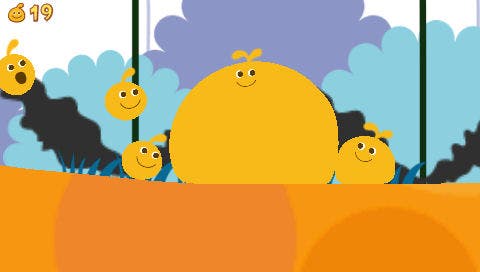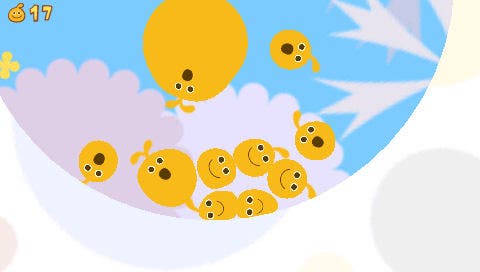LocoRoco
Some thoughts on the demo. Principally, "woot!"
I saw a poster on the Tube yesterday. No, not those stupid Orange mobile phone ones with the raccoon and dolphin and panther balloon animals that are meant to be different talk plans (the future's bright! The future's full of hot air!); it was for some film I didn't bother to remember the title of, and it said "This year's breakout cult classic! Showing soon." And I got so confused by the contradiction that I went back just to make sure it didn't say "Cos, you know, it got good reviews then nobody went to see it, but now it's BACK! FIVE THUMBS UP!" or something in small print. But it didn't. I still don't fully understand.
Anyway! Say hello to LocoRoco - this year's breakout cult classic!
You've probably already downloaded the demo, which - in a fit of better-late-than-never-ness - Sony's made the first to be available off the Internet for PSP. In which case we can sit here for a bit and wink and smile knowingly at each other, because it really is special. Somewhere between Mercury, Mario and Yoshi's Universal Gravitation lurks the niche this now occupies, and it's one you sorely need to explore.

On the surface, it's a simple left-to-right 2D platform game - the twist being you control your character(s), a smiley orange blob, by using the shoulder buttons to tilt the screen left or right about 30 degrees so it rolls along, and pressing both shoulders together to jump. As you go, you're on the lookout for red flowers, which enable you to multiply when you rumble over them. I say multiply, but basically it adds another one - another orange blob for the collective, giving you another life, of sorts, but also altering your momentum.
The basic idea is to maintain that momentum as you navigate fairly simple platforms, jumps and gentle puzzles, but the latter also draw on the game's other trick - your increasingly bulky blob's ability to split into its component mini-blobs. By pressing circle, you split into as many as you've built up, allowing them to filter through narrow estuaries, move more quickly and outmanoeuvre enemies.
Once you're split, the screen draws back to keep track of separate blobs, but never at the expense of slowdown. There's one occasion in the demo where you might find it hard to keep track - not of the blob-units themselves, but the things one of them's trying to evade - but it's not a critical failure. Once you've navigated whatever peril you're facing, you can rejoin the blobs by holding circle and tilting the screen so they all pool together in a corner - merrily yelling what sounds like a childish chorus of "joooooin!" as they do so.

By letting go of circle before they all jooooin you can make smaller blob-groups, and, in a nod to Mercury, split into a pair of blob groups in different areas to tackle problems that require a bit more speed than you have in bulk form. There's a lot of smiley experimentation, because it quickly becomes apparent that you can't find all the little red plants just by sticking to the path in front of you. As well as evading enemies, you'll split off so a smaller group can try and sneak through the stomping legs of what appears to be a kind of squatting waterboatman to reach a wayward flower. Not all creatures mean you harm - most enemies are easily distinguishable black spiky nasties, and apart from a pesky owl who spits some out there's also a kind of bipedal ladybug with a snork-nose who sucks you in, rotates his head back and fires you out when you press the shoulders together, allowing you to target a switch in the ceiling and then head through the pathway it opens.
The demo level's full of little secrets, and the way they're telegraphed or gently hidden speaks very promisingly of the game design as a whole - when you suspect there's a secret, or you've given a glimpse of one, reaching it is somewhere between Sonic-style walking-behind-the-wall and intuition. It's clear and subtle at the same time, and encourages replay. (I just paused mid-sentence to play through the level again to check on a small fact, and I found even more stuff I'd missed on the previous ten occasions I'd gone through it.) There are clear benefits to seeking things out, too - not just in your high-score at the end. At one point, you saunter past a sleeping moon, and if you have enough blobs, they all split off, line up and sing him to life, which opens up another area. Even when you reach the end of the level - you pause in-between some tulips to finish - you can go a bit further, balance on a seesaw and find another red plant upon a ledge.
It'd be easy to dismiss the game's charm as some sort of excitable reaction to the unusual controls - and I'm certainly excitable - or to complain that the limited tilt arc is restrictive, but I reckon to do either of those things would be to miss the point. The arc is ideal for the level design, and the level design in the demo is interesting, occasionally smilingly inventive and full of hidden bits you want to track down.

The charm's the cherry to the tasty cake. The ingredients are just right. It may look like a cookie-cutter platform game about a bunch of wobbly anthropomorphic jellybeans (although that's not even English. And what does "cookie-cutter" mean? This is a rubbish sentence), but the physics are just right for each gelatinous whole, the jump height varies depending on how long you depress the buttons, and even obscure design ideas come off with zero explanation. When I leapt off a trampoline onto some squidgey circular footholds, I sort of knew they'd propel me further than the usual platforms. So I set about leaping between them collecting pink bees, eventually emerging onto a platform where I picked up a little black man out of Doshin the Giant - or so he appeared - and even he made some sort of sense. He waved, anyway. There are three of him to collect.
There are lovely touches abounds - as I sit and type, leaving the blobs to their own devices, they bounce inquisitively around the little platform they're on, their eyes darting this way and that and eventually settling back on me. All the while a giddy theme tune plays over the top - it wouldn't be out of place on the Katamari Damacy CD; it's like Cherry Blossom Colour Season with an upbeat twist - and streamers of clouds dart across the background. It's positively beaming.
The whole thing's delightfully silly and personal, like Mario let loose in Keita Takahashi's idea box, and easily the most exciting thing I've played on the PSP. So yes, here's to this year's breakout cult classic. It's out on June 23rd. And hurrah for this program of PSP demos, Sony - this one's a joy.
LocoRoco's due out in Europe on June 23rd. We'll have a review up closer to release.



